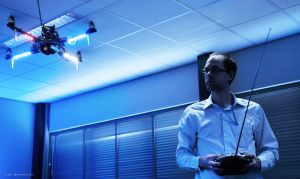 The National Aerospace Laboratory (NLR) recently opened a lab for conducting unmanned aerial system (UAS) activities. SMEs and industry can also use this new UASlab, which features an obstacle course for practicing navigating mini-UASs through tight spaces. Further, UASlab researchers can program and work on mini-UASs at the lab. Using a multi-touch table (a ‘table size iPad’), researchers are able to maintain an overview of the area and work easily together. The lab also contains a control station for larger UASs.
The National Aerospace Laboratory (NLR) recently opened a lab for conducting unmanned aerial system (UAS) activities. SMEs and industry can also use this new UASlab, which features an obstacle course for practicing navigating mini-UASs through tight spaces. Further, UASlab researchers can program and work on mini-UASs at the lab. Using a multi-touch table (a ‘table size iPad’), researchers are able to maintain an overview of the area and work easily together. The lab also contains a control station for larger UASs.
Miniaturisation of Unmanned Aerial Systems (UAS) is a trend that has recently accelerated and won increasing civil and military importance. Unmanned planes will eventually find a broad area of application; that is, not only for military deployments but also for inspecting pipelines, monitoring objects or as cartographical aides. There are however still a few hurdles to overcome before all these unmanned machines can effectively be deployed for such purposes.
At present, UASs largely depend on GPS for navigation and are vulnerable to strong winds. Moreover, they still require a more proficient means of propulsion, and it is also vital to reduce the size of the sensors they carry. In addition, NLR is studying regulatory aspects and the sometimes complex UAS operations.
NLR established this UASlab in order to closely monitor developments and initiate its own innovations in this field. The Dutch armed forces, the Dutch national police agency (KLPD), and the national land registry (‘het Kadaster’) are already benefiting from the expertise developed by NLR.

